If you haven’t come across the idea of a phantom load, it is the amount of power (in watts) that an appliance draws when it is plugged into the power supply but not doing anything useful. Now you would think that when an appliance is turned off, it would not use any power at all, but this is not always the case. The power used may keep the appliance warmed up and ready for use, power an LED clock or have some other function. While the load may be very small, the appliance is likely to be plugged into the power supply 24/7 and even a small load can add up over time, increasing your electricity bill without doing you any good. Also, seeing as there are likely to be a number of appliances in this state, the power consumed would be additive.
I have been aware of this for many years and have a couple of bits of equipment that can be used to measure it and because there are a number of ways to do it, as it turns out, some are better than others.
I have two main classes of equipment that I can use to measure a phantom load. One is connected to the incoming electrical house circuit and measures the draw of everything in the house at the same time, the other is plugged in to the power outlet and then the appliance is plugged into it so it records the power usage of one appliance over time.
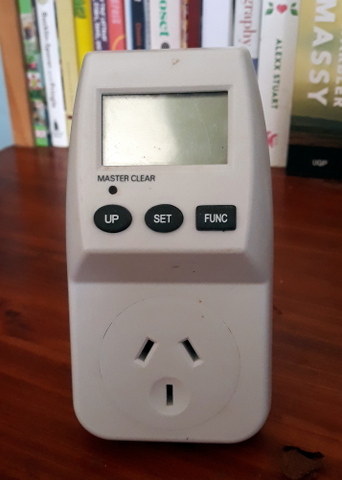
I started out with a plug-in Multi-function Power Meter, MS 6115, (See photo above)which was cheap and complicated to use but did the job. What it could not do was tell me how much the big stuff that was directly wired into the house circuits was consuming. Things like air con, electric hot water, the electric cooking range and lights.
A bit over ten years ago I found out about the ‘Elite Classic’ energy meter from Efergy (See photo below), which was more expensive, connected directly to the incoming power supply (you need a sparkie to do this!) but gave a real time total of electrical energy being used at any one time. I could use it to check individual appliances by turning the appliance off and on and noting the difference in current draw.
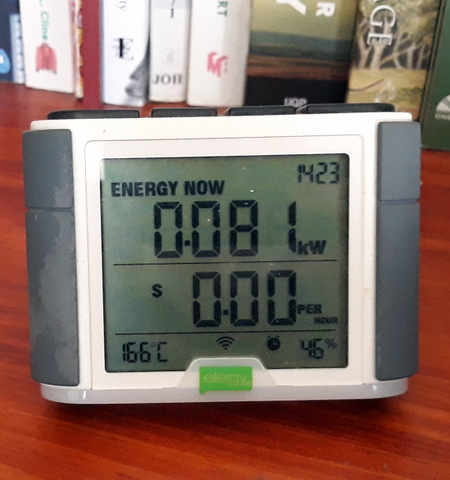
Our energy meter remains connected to this day and as well as telling us minute to minute how much electricity we were using it had a couple of unlooked for benefits.
1. It really focussed us on the amount of power we were using, so we would tend to turn things off (including lights) when not in use to see how low we could get it, and
2. If something, particularly a large draw like the hot water (ours is solar with electric boost through a switch) or some other heater was left on when it was not supposed to be, it became immediately obvious. If the power consumption seemed a bit (or a lot) high when we walked past and looked at the meter, questions were asked!
So, our system seemed to be working well, all up until a few weeks ago when things just didn’t add up!
A while back our microwave oven died, requiring us to buy a new one. No problem really, bought it, set it up, plugged it in and away we went. The previous microwave, using the ‘Elite classic turn on and off’ method, I had measured its phantom load at 20 watts, and was interested to see what the new one was. Using the same method, it came in at 70 watts! I thought it was a bit large but it was what it was. Needless to say, when not in use it was turned off!
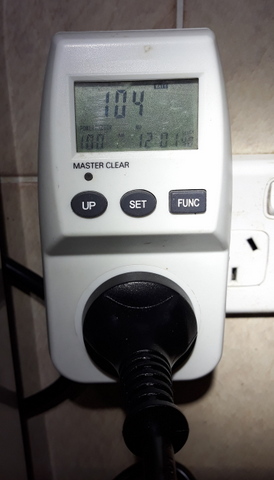
It became a problem when I posted on social media what I had found, suggesting to people that checking phantom loads was a good thing. This resulted in several people calling out my results, saying it was far too high and the measurement was inaccurate. This concerned me so I brough back out my old MS 6115 power meter, hooked it up and then turned on the switch. Low and behold it gave me a reading of 104 watts, (see above) which made even less sense! With the microwave oven turned on but not functioning, it was consuming the same as a 100 watt incandescent light bulb? That made no sense!
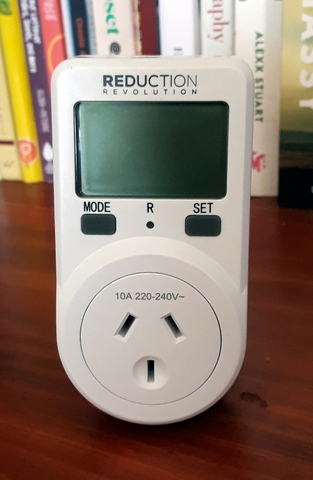
After putting up another post about the second reading I was directed to another piece of equipment simply called a Power Meter (Model No RRPM03) from Reduction Revolution, (See photo above) available for the tremendous cost of $20! (Plus postage) I got hold of one set it up and whammo! It gave me a reading of 1.1 watts (See below)! This was more in line with what I had been led to expect, but was in direct opposition to my main power meter, the Elite Classic.
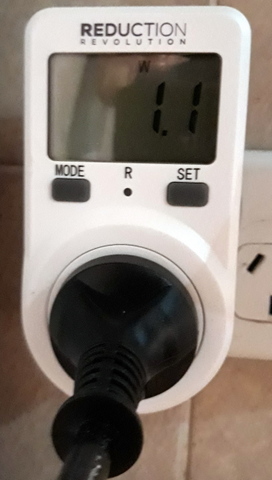
I emailed the manufacturer (Efergy) using the ‘Contact Us’ form on their website explaining the issue and asking for their thoughts. No response! After espousing the benefits of the Elite Classic for over 10 years I have come to question whether it is accurate or not.
So, where to from here? My immediate thought was an electricians clamp meter, however after discussing my problem with a local electrician he said that the very low level of wattage may be an issue, I may need to use it on the supply wiring to the socket and that whatever happened I would need a good quality (ie expensive) meter not a cheapie. In the end it became a moot point because I was unable to get hold of one.
What I was able to get hold of was a ‘Home Energy Efficiency Kit’ (more on this later) which I could borrow from our local library for a couple of weeks. Part of the kit is a ‘Powertech Plus’ power meter (No MS-6108), which can be used to measure, among other things, the phantom load of appliance in watts. I connected it up and turned it on at the wall and – you guessed it! – 1.3 watts.
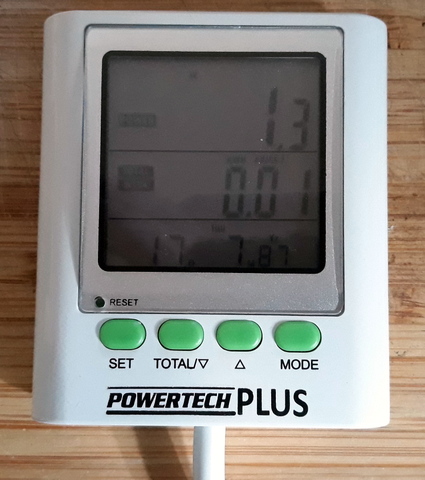
This result has shaken my trust in the accuracy of the ‘Elite Classic’ and caused me to re-evaluate its performance, particularly where small loads are concerned and as such, I can no longer recommend its use. It has also caused me to re-evaluate some of the readings taken previously by using the newer equipment.
Also, to avoid paying the price for a phantom load, simply switch your appliances off at the wall when not in use!
The Library
While I have you, I would like to suggest that you contact your local library and/ or council to see if they can lend you a ‘Home Energy Efficiency Kit’. If they don’t offer the use of one, I think it would be a wonderful idea for you to petition them to get a couple for general lending to people who can’t or don’t want to buy their own. The kit consists of –
1 x ‘Powertech Plus’ power meter (No MS-6108),
1 x ‘Protech’ QM7410 Infrared thermometer
1 x Thermometer
1 x pamphlet explaining how to use the kit,
1 x Home energy Efficiency Worksheet
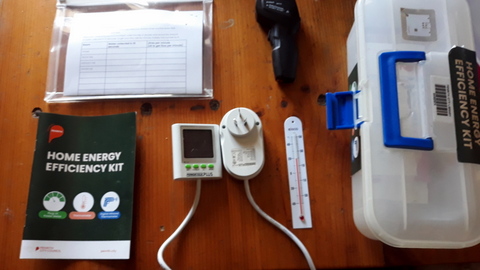
It would make saving energy and saving money on electricity usage easier if everyone had access to one of these kits!


